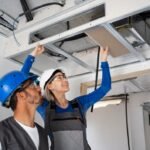Many homeowners dream of having a cozy outdoor living space complete with things like an attached deck fireplace. But some of your biggest problems arise when that planning tries to become a live worker, looking for help on how to plan an engaging design. Ranging from worries about weather to fire safety or finding the right style that matches your home, such an idea must be turned into reality through a thorough plan. In a nutshell: By selecting ideal materials, designing for ventilation and taking into account elements that complement the architecture of your dwelling you will end up with an outdoor area which is cozy year round.
Read this next, a step-by-step process of covered deck design with fireplace adjoining to your home.
Why Add a Covered Deck with a Fireplace?
Homey covered deck with fireplace Here, the possibility of a covered patio helps create outdoor space usable for most months to entertain or simply unwind. On top of that, it increases the value to your property which in itself is a worthy investment. On the other hand, a fireplace gives warmth and ambiance whereas its cover from intense climate conditions.
Choosing the Right Deck Material
The foundation of any deck design lies in selecting the best material for durability, aesthetics, and safety. Here are some top options:
- Composite Decking: Durable and maintenance-free composite materials are highly resistant to warping, splintering. This option also comes in a selection of colors and finishes, which could enable you to coordinate it with an existing exterior home.
- Wood Decking: One of the pergola materials for a rustic style placebo. Typically hardwood, cedar or pressure treated pine, these could be sealed and so long as they may very well last for a number of years. Opt for hardwood if durability matters or, cedar and teak could be your choices which have a natural resistance to the weather.
- PVC Decking: PVC is virtually impervious to moisture and problems related with bugs, which makes it a perfect choice for a covered deck. But this is usually a more expensive option to implement initially.
Deciding on the Fireplace Type
There are multiple types of fireplaces to consider, each offering a different look, feel, and level of maintenance.
- Built-In Masonry Fireplace: Typically made of brick or stone, these fireplaces have a built-in look that projects a traditional aesthetic. More expensive and a longer-lasting, vibrant deck focal point.
- Freestanding Fireplace: Versatile and Easy to be MovedIf you have a freestanding fireplace such as metal chimineas or even cast iron unit, this thing must make me little jealous. The timber models are primarily solid fuel and also have an old world appearance.
- Electric or Gas Fireplaces: Electric/Gas fireplaces are safest alternative and eco-friendly as they have a cleaner burn, require less maintenance and offers various designs.
Planning for Safety and Ventilation
Safety is paramount when adding a fireplace to any deck. Here are a few important considerations:
- Ventilation: If you have a covered deck, it is meant to be vented so smoke will not congregate. Have ventilation measures such as screened windows or open side panels and skylights.
- Fire Safety Regulations: If you want a fire pit on your deck, verify with local code that it is approved for decks. Fire-resistant materials include all types of decking, and for the covering structure as well; maintain clearance distance around fireplace.
- Placement of Fireplace: Find out where the fireplace should be Installed reasonably away from flammable structures, furniture and decor It should provide plenty of space for you to move around.
Selecting the Right Fireplace Fuel: Wood-Burning vs. Gas
The fuel source you choose will impact both the ambiance and upkeep of your fireplace.
- Wood-Burning Fireplace on Deck: This wood burning fireplaces carries a more traditional rustic feel and offers natural wooden crackling sounds. On the other hand, while wood fireplaces are still beautiful to look at and provide a way of grilling chicken when properly managed (heh), they need constant maintenance: cleaning, ash disposal, and have to sit atop surfaces that can resist catching fire.
- Gas Fireplace: Gas fireplace offers convenience, you can turn it on or off with a switch and no ash clean-up required. A gas fireplace provides the “campfire” feel without having to lug in firewood, and is safer for a covered deck.
Choosing a Design Style
Your deck and fireplace should blend seamlessly with your home’s architectural style. Here are a few popular styles:
- Rustic: A rustic deck may incorporate natural wood and stone elements. This style is only strengthened by a wood-burning stone fireplace that makes the space feel like it should exist in a secluded rustic cabin.
- Modern: Go for a steel and tempered glass railing on the deck to showcase an uber-sleek, contemporary feel paired with one of those snazzy gas or electric fireplaces that have super minimal lines.
- Traditional: A traditional layout is typically decked out in classic brick or wood finishes, and might have plenty of seating with comfy cushions and throw blankets.
Adding Essential Features and Accessories
To make your deck as functional and comfortable as possible, consider these elements:
- Seating Arrangements: Arrange furniture around fireplace for maximum warmth and communication. Related ResourcesWeather-resistant teak and aluminum are good choices for patio furniture.
- Lighting: At night, string lights or lanterns turned on create a warm and inviting atmosphere. The LED lights are economical and can be fitted in different styles according to your aesthetic.
- Built-in Storage: A few under-seat storage options or small cabinets for firewood, cushions and other outdoor essentials can help defend against the elements.
- Weather Protection: A covered deck provides partial shelter from wind, rain or snow and you may want to add features such as retractable screens, clear plexiglass panels that act a lot like sliding glass walls or movable tempered-glass partitions.
Maintenance Tips for Your Deck and Fireplace
Regular maintenance keeps your deck and fireplace in top condition and extends its life. Here’s a checklist:
- Inspect Deck Structure Annually: Make sure that no boards, nails or anything is loose.
- Clean and Seal Deck Surface: Clean & Seal Deck Surface Natural Wood decks still need to be refinished every few years.
- Fireplace Maintenance: Remove wood ash after every use in a fireplaces that burns. Fireplaces: Gas and electric fireplaces should be inspected for leaks or other issues at least once a year.
- Cover Furniture: When not in use, protect furniture with weatherproof covers.
Budgeting and Hiring a Professional
Investing money in a covered deck with fireplace. Proper budgeting is a must so do not cut corners and explore hiring an expert to make certain that the work gets done right, whilst saving you money on safety. To building a permanent masonry deck fireplaceLook for legitimate experienced contractors who specialized in both deck construction and fire safety if you plan.
Conclusion
Having a covering over your deck with an outdoor fireplace attached to the house could be the great project because it can significantly help you expand your living area outside. The wood-burning setup may be nostalgic or your modern gas fireplace will make the deck a popular hangout. By following these steps, and giving your workspace a little extra attention you can create an encouraging and warm space that is great for both working in peace or winding down with guests after the work day. Get started now and make your outdoor space a comfortable, inviting sanctuary.







